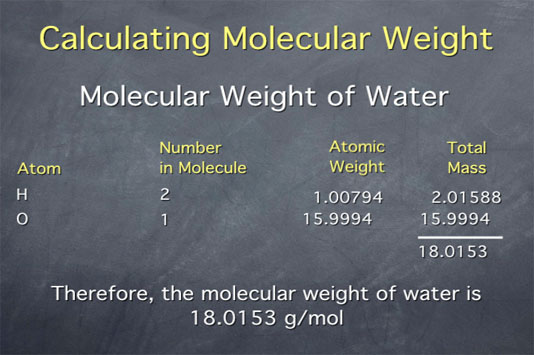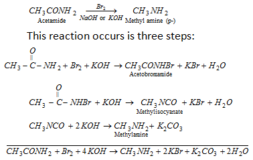molecular weight

source : you tube.com
Molecular Weight of Organic Acids
- Silver Salt method
Silver salt of org. acid on combustion gives silver.
RCOOAg —–>Ag
(R= alkyl gr.)
Eq. wt. of org. Acid (RCOOH)= E
Eq. wt. of RCOOAg =E–1+108 = E+107
Eq.Wt. of silver salt / Eq.Wt. of silver = Wt. of silver salt /Wt. of silver
( E+107) /108 =W/w
Mol wt. of acid = Eq. wt × basicity of acid
Q –0.5 gm. of Ag. salt of dibasic acid on combustion give 0.355 gm. of Ag. Find out the molecular weight of Compd.
W= 0.5, w= 0.355
( E+107) /108 =W/w
( E+107) /108 =0.5/0.355
E =45
Mol wt. of acid = Eq. wt × basicity of acid
=45×2=90 Ans.
Q –
W= 0.9 g, w= 0.582
Acid is monobasic, Mol. wt.=?
Ans.
( E+107) /108 =W/w
( E+107) /108 =0.9 /0.582
E = 167
Mol. wt. of acid = Eq. wt × basicity of acid
=167 x 1 =167
Ans. Mol .wt. = 167
(II) Volumetric Method
gm. equi. of Acid = gm. equi. of base
w /E =N V(l)
w=wt of acid, E=Eq. wt of acid
N= Normality of base V= Vol. of base in litre
Mol./ wt. = Eq. wt. × basicity
Q — 0.12 gm. of a monobasic acid is neutralised by 20ml of N/5 NaOH. Calculate the molecular weight of acid ?
Ans. w /E =N V (l)
w =0.12 gm. ,N =1/5 = 0.2 , V =20 ml. =0.020 litre
0.12 /E = 0.2 x 0.020
E = 30
Mol wt. = Eq. wt. × basicity
= 30×1=30 Ans.
Q — 1.575 gm of an org. acid was dissolved in 250 ml of H2O & 20 ml of this Soln requires 16ml of N/8 alkali soln for complete neutralisation. If the basicity is 2 . Find the mol. wt.
For Acid
w=1.575 gm. N=1/10 V= 250 ml.=0.250 litre
w /E =N V(l)
1.575 /E = 0.250/10
E =63
Mol . wt = Eq. wt. × 2 = 63×2 = 126 Ans.
III Molecular weight of organic base-
- Volumetric Method-
gm. eq. of base = gm. eq. of acid
w /E =N V(l)
w= wt. of base N= normality of acid
E= Eq. wt. of base V= Vol. of Acid in litre
Mol. wt. = Eq. wt. × acidity
Q—0.12 gm. of Mono acidic base is completely neutralised by 20 ml of 0.2 N HCl. Calculate the molecular weight of base ?
Ans. w =0.12 gm. , N=0.2 ,V =20 ml. =0.020 litre
w /E =N V(l)
0.12 /E =0.2 x 0.020
E=30
Mol. wt. = Eq. wt. × acidity
Mol wt. =30×1=30 Ans.
Q—-2.65 gm of di acidic base was dissolved in 500 ml of H2O. 20 ml of this soln required 12 ml of N/6 HCl soln. Calculate the eq. wt. & molecular weight of base.
| N1×20=1/6×12
N1=1/10 |
for base
w=2.65 N=1/10 V=250 ml =0.250 l w/E =NV(l) 2.65 /E =0.250 /10 E =53 Mol. wt. = Eq. wt. × acidity =53 x 2 Mol.Wt= 106 Ans. |
- b) Platini Chloride Method-
H2PtCl6 —–> B2H2PtCl6 ——> Pt
Chloroplatinic Chloro Platinate
Acid Salt
(B is a base)
Eq. wt. of base = E
Wt. of Chloro platinate salt = W gm.
Mol. wt. of Chloro platinate salt (B2H2PtCl6)= 2E+2+195+35.5×6
= 2E+410
Mol. wt. of Chloro platinate salt / At.Wt. of Pt = Wt. of Chloro platinate salt / wt.of Pt
(2E+410) /195 =W/w
Mol. wt. of base = Eq. wt. x Acidity
Q — 0.40 gm platini chloride of a monoacidic base on combustion gave 0.125 gm of Pt. find out the Mol. wt. of base.
Ans. W =0.40 , w= 0.125
(2E+410) /195 =W/w
(2E+410) /195 =0.40/0.125
E =107
Mol. wt. of base = Eq. wt. x Acidity
Mol. Wt. = 107 x 1
Mol. Wt. =107
Determination of Mol. wt. by Physical Methods-
For Volatile compound
- Victor Mayer’s Method
- Hofmann’s Method
- For nonvolatile compound
- Elevation in boilng point method
- Depression in freezing point method
Hofmann’s Method-
This method is applied to those substances which are not stable at their boilng points but which may be volatalize without decomposition under reduced pressure.
Mol. Wt. =( wt. of substance x 22400) / volume of vapours at N.T.P. (ml.)
Victor Mayer’s Method-
Mol. Wt. =( wt. of substance x 22400) / volume of vapours at N.T.P. (ml.)
Volume at N.T.P. can be calculated by Gas eqn–
P1 V1/T1 =P2 V2/T2
P2 , v2 , T2 are at N.T.P.
P2= 760 mm V2= ? ml T=273 K
Vapour Density =wt.of vapours or substance /(volume of vapours at N.T.P. X 0.00009 )
Q —In victor Mayer determination the following observations have been made. wt. of compd= 0.17 gm.
Vol. of air collected = 34.2 ml., temp. = 150C
Atm. pressure = 750 m.m., Vapour Pressure of water at 150C= 13 mm
Calculate the V.D. & Mol. wt. of compd.
Ans.
P1 = 750-13=737 mm
T1=273+15= 288 K
V1 =34.2 ml
P2 =760 mm
V2 =? ml
T2 =273K
P1 V1 /T1 =P2 V2 /T2
(737 x 34.2) /288 =(760 x V2) /273
V2 = 31.44 ml.
Vapour Density =wt.of vapours or substance /(volume of vapours at N.T.P. X 0.00009 )
= 0.17 /(31.44 x 0.00009)
= 60.07
Mol. wt. = 2×V.D. = 2×60=120 Ans.
Q—-0.1133 gm. org. compd on heating displaces 22.8 ml air at 150C & pre. is 750 mm (aq. tension at 15 0C=13 mm) Calculate the Mol. wt.
Ans.
P1 = 750-13=737 mm
T1=273+15= 288 K
V1 =22.8 ml
P2 =760 mm
V2 =? ml
T2 =273K
P1 V1 /T1 =P2 V2 /T2
(737 x 22.8) /288 =(760 x V2) /273
V2 = 20.96 ml.
Vapour Density =wt.of vapours or substance /(volume of vapours at N.T.P. X 0.00009 )
= 0.1133 /(20.96 x 0.00009)
=60
Mol. wt. = 2×V.D. = 2×60=120 Ans.
Elevation in Boiling point-
M =(1000 Kb.w) / ΔT.W
Kb =molal elevation constt.
w =wt. of solute in gm.
W =wt. of solvent in gm.
ΔT = Elevation in b.p.
Also
M =(100 Kb.w) / ΔT.W
Kb= Molar or Molecular elevation constt.
Depression in Freezing Point
M =(1000 Kf.w) / ΔT.W
Kf= molal depression constt.
Δ T= depression in freezing pt.
Also
M =(100 Kf.w) / ΔT.W
=Molar depression constt.







